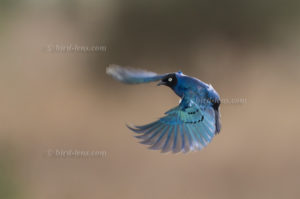 The waterhole at the Salt Lick Lodge attracts an impressive number and diversity of animals and birds. Nevertheless, we do not last long in the lounge area within the lodge. A little later we move in the afternoon heat again. Many other tourists also go to Lions Rock. There are few alternatives. “Feeding forbidden“ a sign says just 100 yards behind the Salt Lick Lodge. A little later, I see why. Superb Starlings are fed from the tourist bus directly from the dirt track. One of the drivers in front of us picks up peanuts and the Superb Starlings (Lamprotornis superbus) pick them in his hand while flying. I hate that – and it’s even prohibited by the sign. Nevertheless, I cannot help but photograph the fluttering right in front of the driver’s door. The word “fluttering flight” does not adequately reflect the perfect aerial acrobatics. The birds have an impressive ability to fly on the spot quickly and at the same time a little later. The elegant standing in the air must be seen. I do not trust this for these compact birds. The blue-violet shines in the sun in ever new variations and the black wing linings on the wings really dance during the upswing and downswing of the wings. Sometimes you can even see the light brown belly with the white chest band. Especially the white eye stands out despite the rapid action. Of course, that does not happen without screaming and constant calling. With wide open beaks, the Superb Starlings try to scare each other off the much anticipated food source. A Northern White-Crowned Shrike or White-rumped Shrike (Eurocephalus rueppelli) observes all of this from a tree along with a troop of excited Superb Starlings. A Red-billed Hornbill (Tockus erythrorhynchus) also arrives and can be fed from the hand. A flock of Red-billed Buffalo-Weaver (Bubalornis niger) is also not far and is roaming the dry grass crumbles fallen down.
The waterhole at the Salt Lick Lodge attracts an impressive number and diversity of animals and birds. Nevertheless, we do not last long in the lounge area within the lodge. A little later we move in the afternoon heat again. Many other tourists also go to Lions Rock. There are few alternatives. “Feeding forbidden“ a sign says just 100 yards behind the Salt Lick Lodge. A little later, I see why. Superb Starlings are fed from the tourist bus directly from the dirt track. One of the drivers in front of us picks up peanuts and the Superb Starlings (Lamprotornis superbus) pick them in his hand while flying. I hate that – and it’s even prohibited by the sign. Nevertheless, I cannot help but photograph the fluttering right in front of the driver’s door. The word “fluttering flight” does not adequately reflect the perfect aerial acrobatics. The birds have an impressive ability to fly on the spot quickly and at the same time a little later. The elegant standing in the air must be seen. I do not trust this for these compact birds. The blue-violet shines in the sun in ever new variations and the black wing linings on the wings really dance during the upswing and downswing of the wings. Sometimes you can even see the light brown belly with the white chest band. Especially the white eye stands out despite the rapid action. Of course, that does not happen without screaming and constant calling. With wide open beaks, the Superb Starlings try to scare each other off the much anticipated food source. A Northern White-Crowned Shrike or White-rumped Shrike (Eurocephalus rueppelli) observes all of this from a tree along with a troop of excited Superb Starlings. A Red-billed Hornbill (Tockus erythrorhynchus) also arrives and can be fed from the hand. A flock of Red-billed Buffalo-Weaver (Bubalornis niger) is also not far and is roaming the dry grass crumbles fallen down.
Superb starlings are some of the most colorful birds endemic to northeast Africa, but you will likely hear these birds long before you can spot them in the bushes of eastern Kenya. These passerine birds are very vocal and have a variety of different calls they use to communicate with one another. They likely need to be so loud to be heard above the group, as the starlings live in large flocks that can number well into the thousands.
These birds have distinct coloration that makes them easy to pick out. Superb Starlings are about eight inches long with iridescent blue-green feathers on their backs, wings, throats and tails, with white feathers on the undersides of the wings and tail. The white collars – that separate their throat feathers from their bellies – stand out from a breast of a rusty-orange color.
Superb Starlings tend to stick to wooded areas near water courses where the air is dry. Their food of choice is pretty much any insect they can get. But fruits, berries and plant nectar will do when there are no insects to be found. They often travel to human settlements to snatch up scraps of food, so it is not difficult to check these birds.
We were located in the Lions Bluff Lodge. The lodge is highly recommended and easily accessible from both Mombasa and Nairobi. Lions Bluff Lodge is a small exclusive lodge which clings to the edge of a bluff suspended above Lumo Community Wildlife Sanctuary which lies at the heart of the Tsavo eco system,
To cope with the growing demand for top shots of the rarer species of the Palearctic Bird-Lens is keen to enrich the range of pictures of birds you can find; and this not only in the Western Palearctic. Beside the image of the blog you can find a nice selection of birds in the gallery or in the “Picture Shop” very soon. Just give a message, if Bird-Lens.com could serve you with an image needed before the new pictures are online.